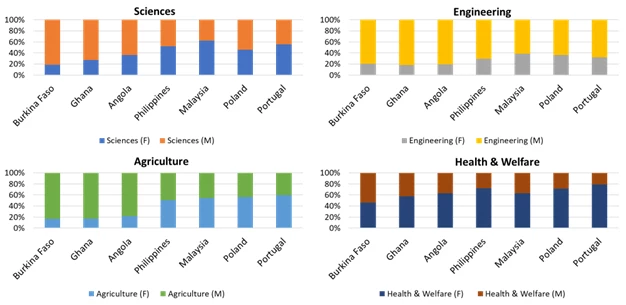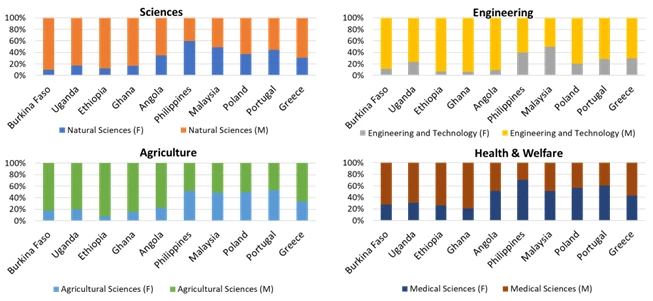 Capitalizing on STEM education and skills can help Africa leapfrog as a global leader in addressing trends in emerging technologies, cyber security, climate change, the green economy, and global health. Copyright: Stephan Gladieu/World Bank
Capitalizing on STEM education and skills can help Africa leapfrog as a global leader in addressing trends in emerging technologies, cyber security, climate change, the green economy, and global health. Copyright: Stephan Gladieu/World Bank
An estimated 2.5 million more engineers are needed in sub-Saharan Africa to tackle its development challenges, yet, as things stand, the region falls short of meeting this demand. What is the missing link?
Science, technology, engineering, and mathematics (STEM) represents a vast and crucial domain of knowledge. Integrated STEM Education, a dynamic pedagogical approach, surpasses traditional teaching methods by intentionally weaving these four fields into a single cross-disciplinary program. It cultivates both technical and 21st-century skills through real-world problem-solving.
In principle, STEM skills encompass a blend of technical and soft skills acquired through authentic integrated STEM programs. However, globally, STEM skills typically refer to the technical competencies acquired through STEM education, without strict adherence to a specific pedagogical approach.
The question now is: Can STEM skills unlock Africa’s path to prosperity?
Revolutionizing Africa’s STEM ecosystem
Now more than ever, automation, artificial intelligence, and the internet of things continue to drive the fourth industrial revolution and the future of work. Revolutionizing Africa’s STEM ecosystem is urgent. These fields are highly STEM dependent and research shows that countries with high STEM human capital are competitive, productive, and experience high economic growth.
The African Union’s Agenda 2063 recognizes the strategic role STEM education can play in fast-tracking Africa’s development. Therefore, Africa needs to capitalize on STEM education and skills to leapfrog as a global leader in addressing mega developmental trends in emerging technologies, cyber security, climate change, green economy, and global health. Most importantly, the ability of Africa to convert its youth dividend–with a projected 362 million young people between 15-24 years by 2050—into a highly skilled STEM workforce can be a game changer.
Challenges for STEM education
Although Africa is committed to promoting STEM, as evidenced in regional and national science, technology and innovation or STEM education policies in Ethiopia, South Africa and Nigeria, numerous challenges hinder STEM education.
A major constraint is low participation and a weak pipeline in STEM fields, with less than 25% of higher education students pursuing STEM fields, of whom less than 30% are women. This trend subsequently impacts graduation rates (figure 1). Only 18% to 31% of science researchers are women. This issue is partially due to the lack of students’ awareness of the career opportunities in STEM.
Another constraint in Africa is inadequate infrastructure and resources including low access to electricity and internet connectivity, combined with lack of smart classrooms, science laboratories and equipment. Approximately, 4 out of 5 of secondary schools in Africa do not have access to electricity and over 90% of schools lack appropriate science labs, however, this figure varies from country to country. In Rwanda for example, 21.6% of secondary schools have science labs compared to 18% in South Africa.
Although most African countries adopted a competence-based curriculum, which is skills-oriented and learner-centered, lack of capacity and inadequate training oblige STEM teachers to resort to traditional, teacher-centered techniques, which are ineffective for STEM learning.
Figure 1. Female graduation rates in STEM fields in sub-Saharan Africa (SSA) are low

Tackling youth unemployment with STEM
As a result of the above and other constraints, youth unemployment rates in Africa remain a great challenge and barrier to the region’s economic growth and prosperity, with an estimated 83% of youth entering the labor market remaining jobless due to skills mismatch and a general lack of prospects. Adding to this, is the gross underrepresentation of women in the STEM workforce. In most sub-Saharan African countries, women researchers are underrepresented across STEM fields, especially engineering (figure 2). This is not due to a lack of talented young women on the continent, as evidenced by the work of remarkable young women like Moyinoluwa Anoma, founder of Women in Data Africa (WiDA), and Angela Tabiri, founder of Femafricmaths.
To address some of the challenges in easing the transition from school to the labor market, universities are developing inclusive innovation hubs and incubators to help ease the transition into the labor market and provide students the opportunity to practice what they have learned and develop entrepreneurial skills. Companies emerging from these centers have been found to generate more jobs and sales than companies emerging elsewhere. Currently, sub-Saharan Africa has 186 incubators based in universities across various countries including: Ghana’s Climate Innovation Center, which focuses on developing environmentally conscious businesses, and the Africa Blockchain Incubator Program in Rwanda, which supports participants in the development and launch of their blockchain projects.
Figure 2. Female participation in the STEM workforce is low in SSA

Prioritizing STEM skills for Africa’s youth requires the collective engagement of governments, educational institutions, and the private sector. Three key areas of focus emerge as recommendations:
- Enhancing STEM awareness and access: Efforts should be directed towards creating opportunities for STEM discovery such as the establishment of science centers, targeted campaigns, community engagement programs, partnerships, and other STEM initiatives with local educational institutions to raise awareness and improve access to STEM education. Creating a culture that promotes the value of STEM, especially among girls and their families, can overcome enrollment barriers.
- Transforming STEM education: This requires curriculum alignment, focus on modern teaching approaches, and investments in teacher training and professional development. Updating the curriculum to align with real-world challenges, integrating practical experiences and problem-solving will facilitate a shift towards a more authentic STEM approach leading to quality STEM education.
- Fostering entrepreneurship and innovation ecosystems: Investing in incubators, innovation hubs, and startup support programs fosters entrepreneurship and innovation ecosystems. These initiatives provide practical opportunities for young people to apply their STEM skills, fostering creativity, collaboration, and problem-solving abilities. Promoting diverse teams, including women researchers, is essential for inclusive innovation and holistic solutions.
Finally, collaboration and knowledge-sharing between African countries is paramount for accelerating progress in STEM education and innovation. By working together, sharing best practices, and supporting one another, we can unlock the potential of the African youth for sustainable development and economic growth in Africa.
To receive weekly articles, sign-up here






Join the Conversation